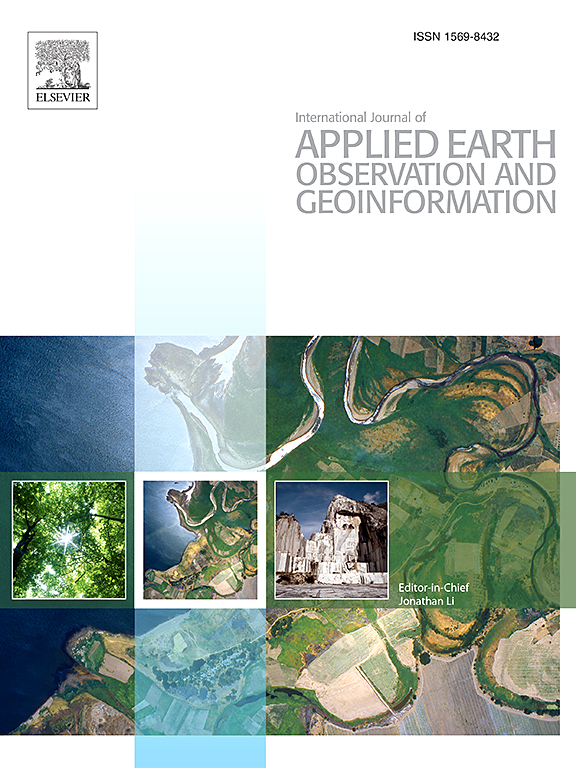机器学习算法的训练和推理时间效率评估框架:高光谱图像分类的案例研究
IF 8.6
Q1 REMOTE SENSING
International journal of applied earth observation and geoinformation : ITC journal
Pub Date : 2025-05-29
DOI:10.1016/j.jag.2025.104591
引用次数: 0
摘要
遥感数据集的复杂性和规模日益增加,再加上准确估计算法时间效率的挑战,在紧急或资源受限的情况下使用机器学习算法时,往往会导致严重的资源浪费甚至失败。准确的时间效率估计对于部署有效的算法至关重要,但由于影响计算性能的因素很多,因此仍然具有挑战性。传统的时间效率评估方法往往忽略了核心模型参数和复杂数据尺度在光谱和时间维度上的影响。此外,推理时间是实际应用程序中的一个重要因素,但常常被忽视。为了解决这些限制,我们提出了时间效率评估框架(TEAF),这是一种评估机器学习算法时间效率的新方法。通过数学推理,TEAF将训练和推理时间建模为复杂数据尺度和核心模型参数的函数ψ。ψ和实际运行时间之间的强线性相关性使得TEAF能够在算法执行前以较低的计算开销准确地预测机器学习任务的时间和成本。为了验证这一框架,我们推导了五种经典机器学习算法的TEAF公式,并在最先进的高光谱图像数据集和Sentinel-2多光谱数据集上进行了测试。结果表明,TEAF可以准确预测各种算法的训练时间和推理时间,ψ与实际运行时间之间具有很强的线性相关性(R2>0.942)。该研究为遥感图像处理中数据量和复杂性的增加所带来的挑战提供了一个实用的解决方案。代码可在https://github.com/SCUT-CCNL/TEAF上获得。本文章由计算机程序翻译,如有差异,请以英文原文为准。
Training and inference Time Efficiency Assessment Framework for machine learning algorithms: A case study for hyperspectral image classification
The increasing complexity and scale of remote sensing datasets, coupled with the challenges of accurately estimating algorithmic time efficiency, often lead to significant resource waste or even failure when using machine learning algorithms in urgent or resource-constrained scenarios. Accurate time efficiency estimation is critical for deploying effective algorithms, yet it remains challenging due to the many factors influencing computational performance. Traditional methods of evaluating time efficiency often neglect the effects of core model parameters and complex data scales in spectral and temporal dimensions. In addition, inference time, an essential factor in real-world applications, is often overlooked. To address these limitations, we propose the Time Efficiency Assessment Framework (TEAF), a novel method for evaluating the time efficiency of machine learning algorithms. Through mathematical reasoning, TEAF models the training and inference time as functions () of complex data scales and core model parameters. The strong linear correlation between and the actual runtime allows TEAF to accurately predict the time and cost of machine learning tasks with a low computational overhead before algorithm execution. To validate this framework, we derived TEAF formulations for five classical machine learning algorithms and tested them on state-of-the-art hyperspectral image datasets and Sentinel-2 multispectral datasets. The results demonstrated that TEAF could accurately predict both training and inference time for various algorithms, with a strong linear correlation between and actual runtime (). This study offers a practical solution to the challenges posed by the increasing volume and complexity of data in remote sensing image processing. The code is available at https://github.com/SCUT-CCNL/TEAF.
求助全文
通过发布文献求助,成功后即可免费获取论文全文。
去求助
来源期刊

International journal of applied earth observation and geoinformation : ITC journal
Global and Planetary Change, Management, Monitoring, Policy and Law, Earth-Surface Processes, Computers in Earth Sciences
CiteScore
12.00
自引率
0.00%
发文量
0
审稿时长
77 days
期刊介绍:
The International Journal of Applied Earth Observation and Geoinformation publishes original papers that utilize earth observation data for natural resource and environmental inventory and management. These data primarily originate from remote sensing platforms, including satellites and aircraft, supplemented by surface and subsurface measurements. Addressing natural resources such as forests, agricultural land, soils, and water, as well as environmental concerns like biodiversity, land degradation, and hazards, the journal explores conceptual and data-driven approaches. It covers geoinformation themes like capturing, databasing, visualization, interpretation, data quality, and spatial uncertainty.
 求助内容:
求助内容: 应助结果提醒方式:
应助结果提醒方式:


